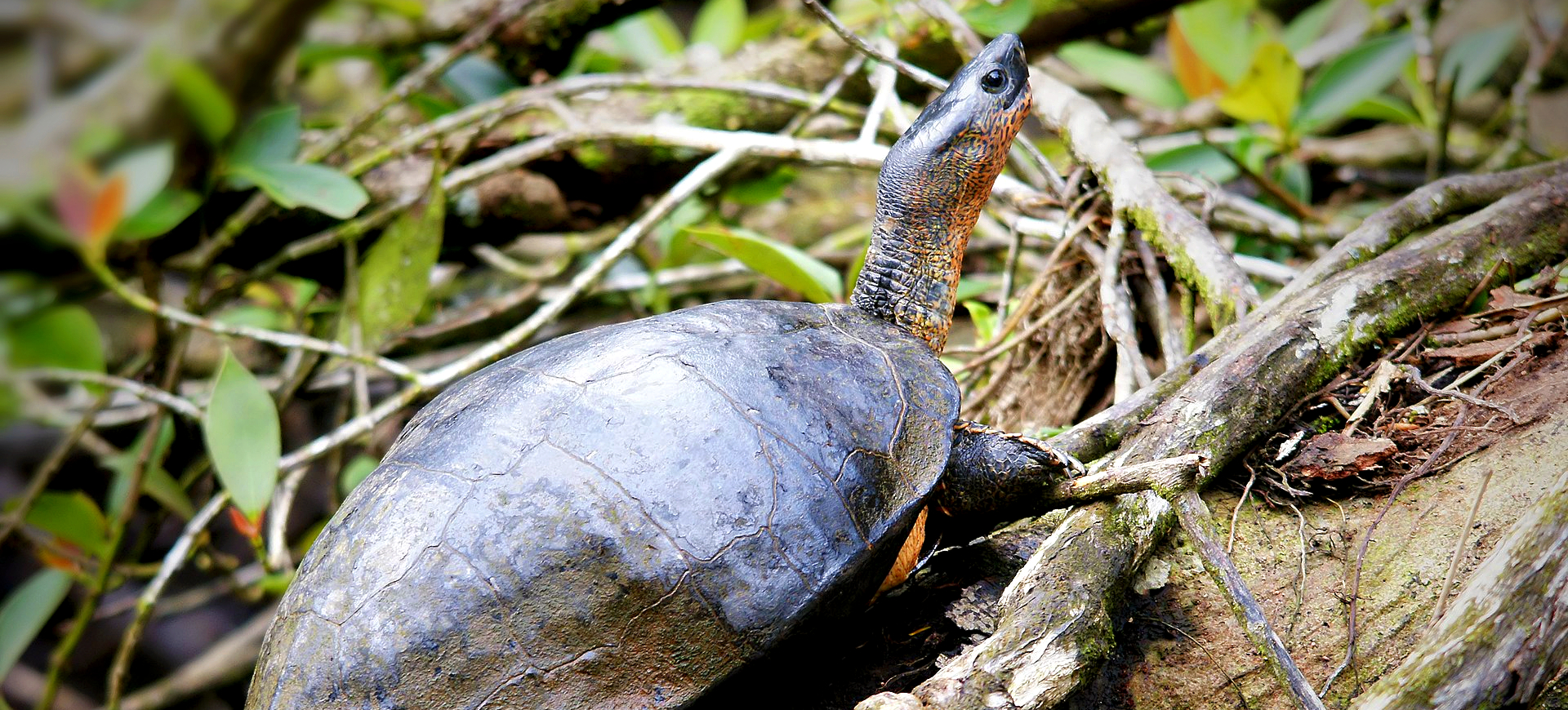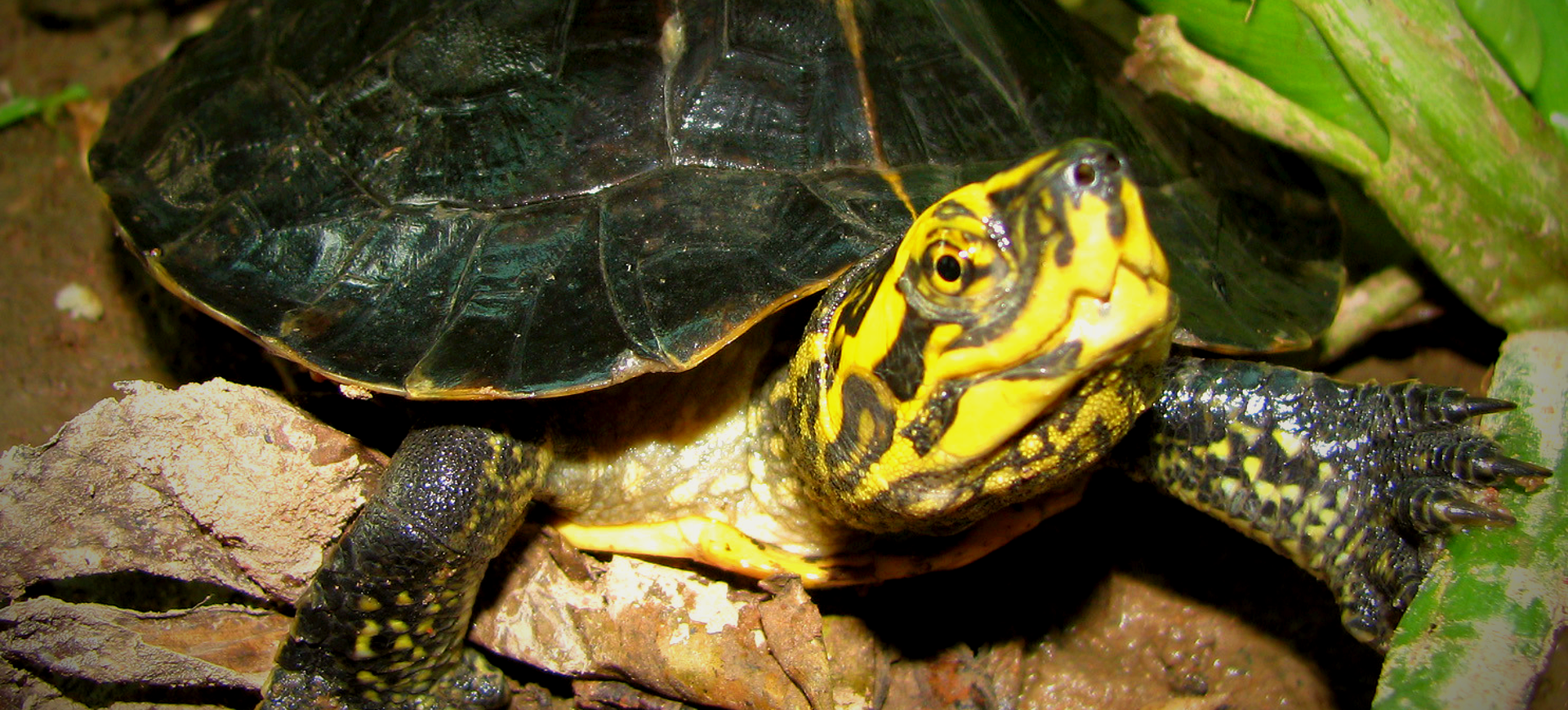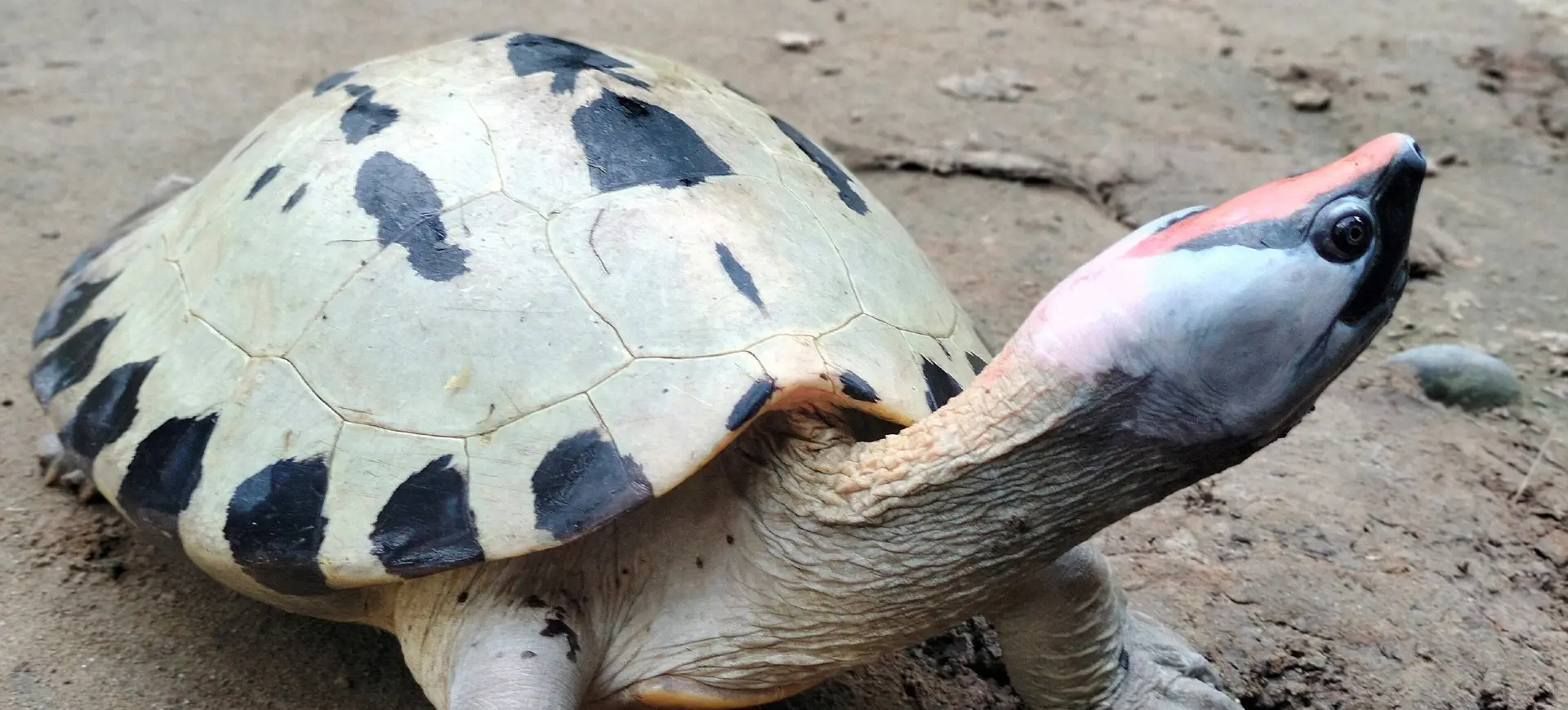Overview
The Spotted Pond Turtle, scientifically known as Geoclemys hamiltonii, is a freshwater turtle native to South Asia. Recognizable by its dark shell with yellowish spots and streaks, this species exhibits a distinctive and attractive appearance. The carapace is typically black or dark brown, adorned with yellow spots that vary in size and pattern. The plastron, or the underside of the shell, is also spotted, creating a striking contrast.
Spotted Pond Turtles inhabit various freshwater environments, including rivers, ponds, and lakes. They are particularly prevalent in areas with abundant vegetation, providing food and shelter. This species is omnivorous, consuming a diet of fish, amphibians, crustaceans, and aquatic plants. The Spotted Pond Turtle plays a significant role in its ecosystem, contributing to the control of aquatic plant growth and the balance of animal populations.
This turtle species is known for its shy and elusive nature, often retreating to the safety of water or dense vegetation when approached. The breeding behavior of the Spotted Pond Turtle involves the female laying eggs on sandy or muddy banks. Conservation efforts for this species are critical due to threats from habitat loss, pollution, and illegal poaching for the pet trade. Protecting their natural habitats and enforcing wildlife protection laws are essential for the survival of the Spotted Pond Turtle.
Taxonomy
Kingdom
Phylum
Class
Order
Family
Genus
Species
Type
Physical Description:
The Spotted Pond Turtle is notable for its striking shell, dark color and distinctive yellow spots. The carapace is typically oval-shaped, with a smooth texture and a strong, robust structure. These yellow spots on the shell provide a form of camouflage in their natural habitat, breaking up their outline in the dappled light of their aquatic environment. The plastron is similarly patterned with spots, making this species one of the more visually striking turtles in its native range.
Spotted Pond Turtles are medium-sized, with adult turtles reaching a carapace length of approximately 9 to 12 inches (23 to 30 cm). The species exhibits sexual dimorphism, with females generally larger and having a broader carapace than males. The limbs and head of the turtle are also dark with yellow markings, and their eyes are typically prominent, adding to their distinctive appearance. The overall physical structure of the Spotted Pond Turtle is well-adapted to their aquatic lifestyle, providing agility and mobility in water.

Lifespan: Wild: ~30 years || Captivity: ~30 years

Weight: Male: 2.2-3.3 lbs (1-1.5 kg) || Female: 2.2-3.3 lbs (1-1.5 kg)

Length: Male: 9-12 inches (23-30 cm) || Female: 9-12 inches (23-30 cm)

Top Speed: Unknown
Characteristic:
Native Habitat:
The Spotted Pond Turtle is indigenous to South Asia, with a distribution that includes India, Bangladesh, Pakistan, and Nepal. Their preferred habitats are freshwater bodies such as rivers, lakes, ponds, and marshes, especially those with abundant aquatic vegetation. These environments provide essential resources like food, shelter, and breeding grounds. The Spotted Pond Turtle thrives in warm, tropical climates and requires access to both aquatic and terrestrial habitats for its daily activities.
The quality and availability of their habitat are crucial for the species’ survival. Spotted Pond Turtles rely on clean water and healthy ecosystems for foraging and nesting. The conservation of these natural habitats is essential, as habitat loss and degradation pose significant threats to their populations. Efforts to protect and restore their natural environments are key to conserving the Spotted Pond Turtle.
Climate Zones:
Biomes:
Biogeographical Realms:
Continents:
Countries:
Diet:
Diet & Feeding Habits:
The Spotted Pond Turtle is an omnivorous species, consuming a varied diet that includes aquatic plants, fish, amphibians, and crustaceans. This diverse diet allows them to play an important role in their ecosystems, helping balance different trophic levels. They are active foragers, often seen hunting for prey or grazing on vegetation in their natural habitats. The Spotted Pond Turtle’s feeding habits contribute to the health of aquatic ecosystems by controlling overgrowth of vegetation and populations of small aquatic animals.
In captivity, the diet of the Spotted Pond Turtle should be carefully managed to replicate their natural feeding behavior as closely as possible. This includes providing a mix of plant-based foods and animal proteins. Proper nutrition is essential for their growth, health, and longevity. The dietary needs of Spotted Pond Turtles reflect their role in the ecosystem and highlight the importance of a balanced aquatic environment for their survival.
Mating Behavior:
Mating Description:
The Spotted Pond Turtle exhibits distinct mating behaviors, with courtship typically occurring in the water. Males court females through specific displays and behaviors, such as gentle biting and nudging. Once a pair is formed, mating occurs in the aquatic environment. The female then selects a suitable location, usually sandy or muddy banks, to lay her eggs.
Nesting behavior involves the female digging a nest where she lays a clutch of eggs and then covering them with soil or sand. The incubation period for the eggs varies depending on environmental conditions, particularly temperature. The hatchlings are independent of birth, immediately reaching the water. Protecting nesting sites is crucial for the successful reproduction of the species, as the loss of suitable nesting habitat poses a significant threat to their populations.
Reproduction Season:
Birth Type:
Pregnancy Duration:
Female Name:
Male Name:
Baby Name:
Social Structure Description:
The Spotted Pond Turtle is known for its solitary nature, with individuals typically interacting only during the breeding season. Outside of breeding, they are mostly independent, each occupying their territory. Understanding the social behavior of Spotted Pond Turtles is important for conservation efforts, as it provides insights into their habitat use and reproductive strategies. The solitary nature of the species underscores the importance of protecting individual habitats and ensuring sufficient resources for each turtle.
During the breeding season, males display courtship behaviors to attract females, indicating a temporary increase in social interaction. Females independently seek out nesting sites, often traveling long distances to find suitable locations. Studying their social and reproductive behavior is crucial for developing effective conservation strategies. Protecting the individual habitats of these solitary animals is essential for their survival and the overall health of their populations.
Groups:
Conservation Status:
Population Trend:
The Spotted Pond Turtle is classified as Vulnerable on the IUCN Redlist, with a decreasing trend in wild populations. The primary threats to this species include habitat destruction, pollution, and illegal capture of the pet trade. Accurate population counts are challenging due to their secretive nature and fragmented distribution. Conservation efforts are focused on habitat protection, law enforcement to combat illegal trade, and raising awareness about the species’ conservation status.
The survival of the Spotted Pond Turtle in the wild depends on effective conservation strategies, which include protecting their natural habitats and ensuring sustainable practices in areas where they live. Research into their ecology, behavior, and habitat requirements is essential for developing targeted conservation actions. Collaborative efforts involving governments, conservation organizations, and local communities are crucial for recovering Spotted Pond Turtle populations.
Population Threats:
The main threats to the Spotted Pond Turtle include habitat loss and degradation, primarily due to agricultural expansion, urbanization, and pollution. The destruction of wetland habitats directly impacts their survival, particularly affecting their breeding and foraging grounds. Illegal poaching for the pet trade and traditional medicine also poses a significant threat, leading to a decline in their numbers. Climate change is an emerging concern, as it could further alter their habitats and affect their reproductive patterns.
Addressing these threats requires a multifaceted approach, including habitat protection and restoration, strict enforcement of wildlife protection laws, and community engagement. Mitigating the impact of climate change and controlling illegal trade are also important aspects of conservation efforts. Public education and awareness campaigns are essential to increase support for conservation initiatives and reduce human-induced pressures on Spotted Pond Turtle habitats.
Conservation Efforts:
The Spotted Pond Turtle’s conservation efforts focus on habitat protection and restoration, particularly in wetland areas. This includes establishing protected areas, implementing sustainable land use practices, and restoring degraded habitats. Captive breeding programs play a crucial role in increasing the population of Spotted Pond Turtles and reintroducing them into the wild. Community-based conservation initiatives are also important, as they involve local communities in protecting and monitoring Spotted Pond Turtle habitats.
Educational programs and awareness campaigns are vital for raising public understanding of the importance of Spotted Pond Turtles and the threats they face. Research on their ecology, behavior, and threats is essential for informing conservation strategies. International collaboration is important for addressing the challenges faced by this species, given its distribution across multiple countries. A combination of habitat conservation, responsible land use, and public engagement is key to successfully conserving the Spotted Pond Turtle.
Additional Resources:
Fun Facts
- The Spotted Pond Turtle’s unique appearance with yellow spots makes it easily distinguishable from other turtle species.
- They can have various vocalizations, which is relatively uncommon among turtles.
- Spotted Pond Turtles play a vital role in controlling the population of aquatic insects and vegetation in their habitats.
- Their eggs and hatchlings are preyed upon by various animals, making their survival rates in the wild relatively low.
- Some cultures value Spotted Pond Turtles in traditional medicine for their supposed healing properties.
- They can remain underwater for extended periods, surfacing only for breathing.
- The species is known for its adaptability to varying water conditions, contributing to its survival in diverse habitats.
- Conservation efforts for the Spotted Pond Turtle also benefit other species sharing their wetland habitats.
- The females’ journey to find suitable nesting sites is perilous, often involving crossing human-developed areas.
- Community involvement in conservation efforts is key to protecting the Spotted Pond Turtle and its habitat.









